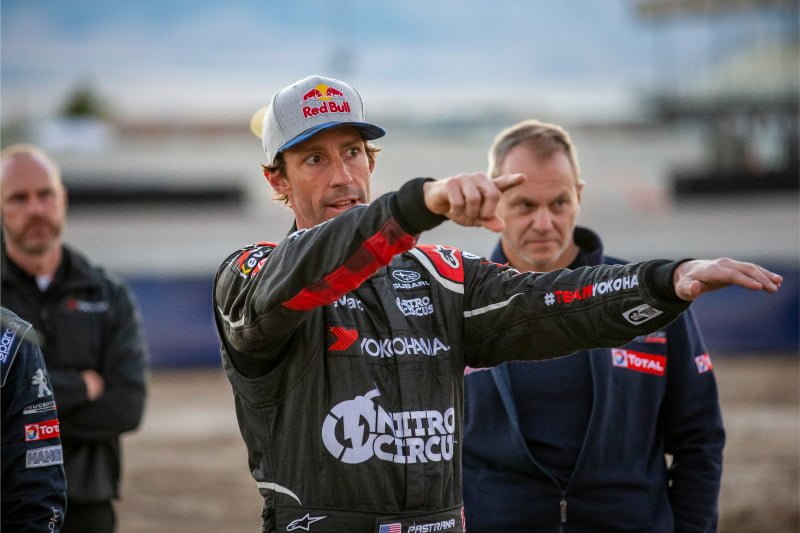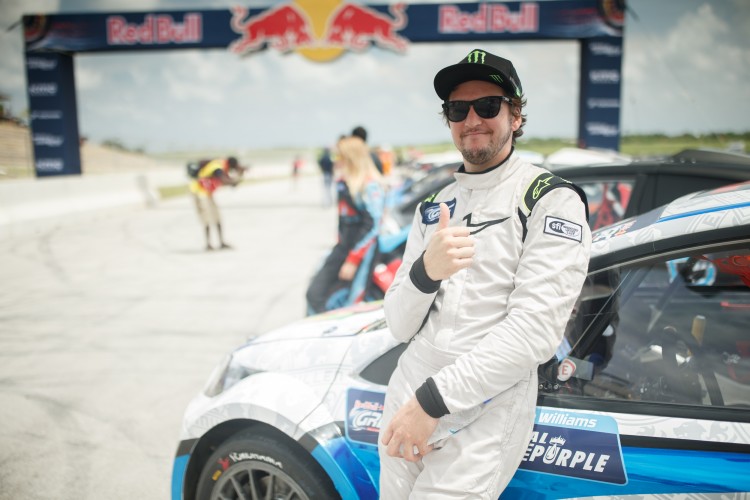Two of freestyle motocross’ biggest stars believe there is a potential for a second wave of action sports competitors to make the move into rallycross.
In the late-2000s and early-2010s, helped by the X Games’ inclusion of rally car, and then rallycross racing, a number of action sports athletes made the switch to four wheeled competition, including Travis Pastrana, Brian Deegan, Bucky Lasek and the late Dave Mirra.
Now Pastrana and fellow Nitro Circus performer Blake ‘Bilko’ Williams have spoken about the possibility of another group of athletes changing codes and moving into four-wheeled competition.

Travis Pastrana was one of the first action sports starts to take up rallycross – Credit: Garth Milan/Red Bull Content Pool
“A lot of our athletes can really drive,” said Pastrana ahead of Nitro Circus Live’s recent stop in Manchester. “On tour we go to every go-kart track and there’s a lot of guys that are in Nitro that aren’t just good at cars, but they pursue it. They drive all the time with shifter karts and stuff and I’m hoping that we can continue that into the future.”
“At the moment Bilko is the only one that I think could be competitive but there are a lot of guys putting in their own time and their own money into it,” added Pastrana. “Even guys like Josh Sheehan, and like James Foster – he’s won the last two X Games gold medals and all he talks about is cars.”
Bilko, meanwhile, has already tested the waters with rallycross, competing in selected GRC Lites races in 2015 and 2016. The Australian said that action sports, particularly motocross, has a number of transferable skills, which makes rallycross an attractive proposition for riders who want to ‘get a roll cage around them’.

Bilko was a podium finisher in GRC back in 2016 – Credit: Josh Tons
“The one thing I felt growing up racing BMX and motocross, particularly motocross, was being able to read the soil – whether it was shiny, hard-packed, loose dirt, how much water was on it, how slick it was going to be,” he said. “It was a really good tool that I had, just by looking at it I knew how slippery it was going to be or how much traction was available.”
“And then racecraft as well, we have the car around us – obviously with dirt bikes you don’t have the cage or anything so there’s a lot more close-proximity racing,” he added. “So just knowing your whereabouts and stuff like that, although it is hard when you’re in a car because you can’t really see – you can only see forwards – but you know how to have a feel for what people are going to do, where they’re going to go, and if someone’s going to run someone wide.”
Bilko took a podium finish at MCAS New River in 2016 and agrees that there is potential within the action sports community, but admits that rallycross’ spiralling costs is the biggest hurdle anyone – not just action sports competitors – has to overcome if they want to move into rallycross.

Bilko was the last big name to transfer from action sports to rallycross – Credit: Larry Chen
“There’s definitely potential to do it, [Josh] Sheehan for one, it’s just the fact that you’ve got to get so much money together from sponsor backing, it’s hard for the guys already doing that,” he said. “Action sports is pretty hard to even get dollars for that now so if you’re trying to get a race budget for a car, it’s a hell of a lot more than doing BMX or dirt bikes.”
Despite the high costs currently in rallycross, Pastrana points out that there has been a natural progression, not just for athletes, but with fans as well when it comes to gaining an interest in rallycross.
“Our audience is getting older – or broader I guess – and when people turn 16, 17, 18, the fans of the guys that ride the scooters, the BMX and skateboards are now rallycross fans,” he said. “I feel like as all these guys start to drive, we can really go with a big platform behind us as far as where a couple of years ago most of our audience wasn’t interested.”

Travis Pastrana pioneered the successful Nitro Rallycross format – Credit: Garth Milan/Red Bull Content Pool



